| View previous topic :: View next topic |
| Author |
Message |
xaprb

Joined: 28 Jan 2021
Posts: 168
|
 Posted: Fri Sep 24, 2021 6:35 pm Post subject: Minolta 800mm f8 Reflex Lens Posted: Fri Sep 24, 2021 6:35 pm Post subject: Minolta 800mm f8 Reflex Lens |
 |
|
xaprb wrote:
I acquired a copy of the Minolta 800/8 reflex lens a while ago. Here are some things I learned from it.
Versions can be identified by their markings and color: 1) black 80cm = 1971 MC-X, 2) black 800/RF = 1977 MD1 or 1978 MD2, 3) white = 1981 MD3. All versions optically identical, white version has a top-mounted handle and a different focusing mechanics (there's a focus ring, with the knob relocated to the left of the barrel.) Mine is the middle of the series' 10-year evolution: neither the early "80cm" one nor the last version with the white barrel and the handle. The lens is heavy and solid, and got heavier as it went, from an initial 1800g to 1960g at the last version.
This lens is really well engineered—with one exception, a very thoughtful and robust design that impresses me a lot. Some of its nice features: it has "gun sights" for looking down the barrel, very helpful for tracking objects without looking through the viewfinder, which shows a very small field of view. It has rear-mounted filters with a retaining clip and a spring-loaded cover that snaps into place when a filter isn't inserted. It has a rotating mount, which lets you reorient the camera 90º when mounted to a tripod using the built-in tripod foot (which is fixed in place). Everything exudes precision machining and design. There is no part of this lens that feels like they chose to save money.
The exception to the great design is the focus knob's location on the right, which essentially precludes handheld usage and makes handling awkward. I know in this lens's day, handheld wasn't really an option, but today we have cameras with stabilization and superhigh ISO, making handheld feasible, at least on bright days. But if you're using your right hand to hold the camera and press the shutter, you have to use your left to hold the lens, and you can't reach around and move the focus knob unless you have a third hand or you let go of the camera. I've considered a way to work around this: wrap a small silk ribbon around the barrel, with a hole in it that fits over the focus knob, and a button sewn to the ribbon on the opposite side where you can move it with your thumb or fingers while balancing the barrel in your palm. It seems workable, in theory, to me. Instead, however, I used it on a monopod or tripod, or just held the lens with my left hand and took my right hand off the camera to adjust the focus. If you're not tracking fast-moving subjects it's usable this way.
The copy I bought was supposed to be "in good condition." Unfortunately that was not the case at all: when it arrived, it was filthy, the focus was almost completely immovable, and there were obvious specks or chips on the primary mirror, which hadn't been shown in the photos. It was in "parts/repair" condition, no question about that. The seller, however, brusquely told me my only option was returning it and paying postage and insurance — to France. I decided to keep it and see if I could rehabilitate the lens.
I found it relatively easy to disassemble, to a point, and it has a number of really interesting design features. First, the rear of the lens is easily removable with four screws that go around the perimeter and screw into the barrel from the rear. Upon removing it, you are holding the mount, the rear of the barrel, the primary mirror, and the corrector elements. The rear mirror is a Mangin design, quite thick and heavy, with the mirroring on the rear surface where it's protected, and the light has to go through the glass twice, enabling it to be used as part of the optical formula. I was now able to assess the specks I had seen through the front. Under a loupe, they were obviously chips. There were several signs of clumsy disassembly with the wrong tools, and my guess is whoever did that dropped some tools on the mirror to make these chips.
#1

After this I was also able to see the rear of the front element, and the secondary mirror, so I could understand more about the focus action. Unlike most mirror lenses, which focus by moving the entire front of the barrel back and forth, this one moves only the secondary mirror. The barrel is fixed, as is the front element. This means the barrel doesn't breathe and suck dust as you focus, and it also means there's no helicoid built into the walls of the barrel, leaking grease into the barrel to deposit haze on the inside of the lens. Additionally, the secondary mirror is set into a small helicoid built into the central obstruction, and the mirror does not rotate as you focus. It only adjusts its position forwards and rear. Thus, instead of having a lot of elements both rotating and moving together and apart, focusing motion is much simpler. In theory this greatly reduces the number of parts whose alignment and centering varies during focusing.
The focusing helicoid is rotated by a small rod that extends from the central obstruction, through a gently spiraled slot in the wall of the barrel, just forward of the front element and behind a short hood that screws into the front of the lens. This rod engages a spring-loaded sliding mechanism under a cover, which I presume is designed to decouple the rod from the optics and protect the helicoid and the front of the lens from shocks if the focusing handle is bumped.
#2

There's a skirt that covers the majority of the focus slot, with a small hole for the lever to pass through. This skirt fits inside the barrel and behind a spring-loaded expansion clip, which is easy to remove and reinsert with the correct tools, and goes into a slot in the inside of the barrel, just behind the threads where the hood screws in. I've indicated the slot with a red arrow here.
#3
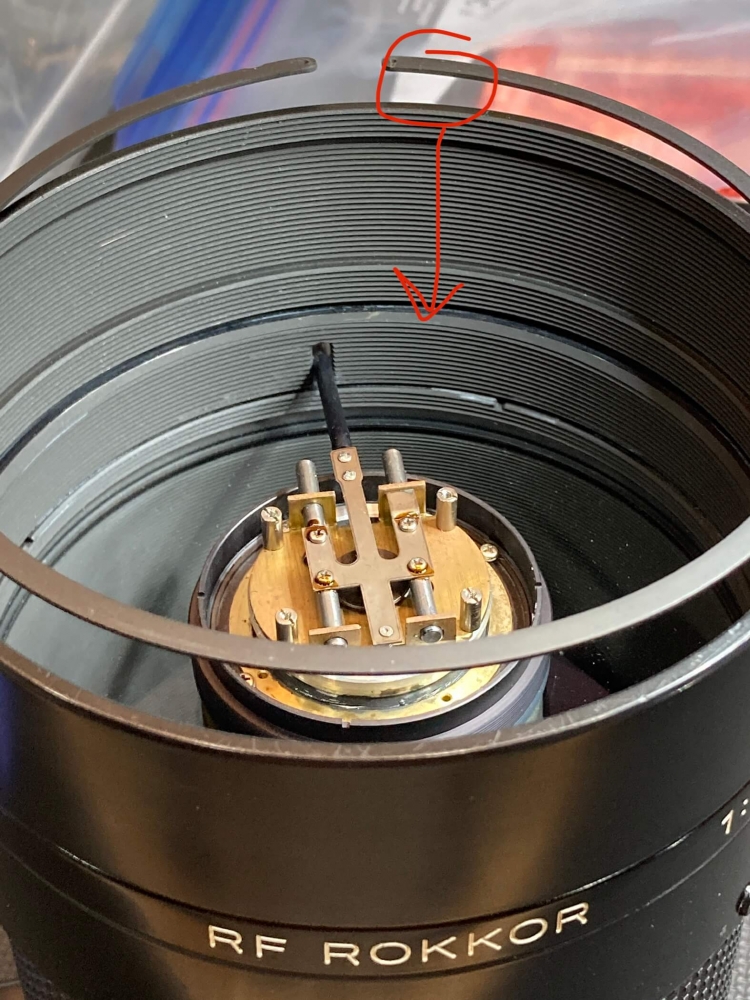
I decided to remove the front hood next. Unfortunately the hood was not budging. I'd seen a couple of these for sale with the comment "the hood is difficult to mount and unmount" so I thought it likely that it was a common problem, and simply needed some lubricant to unseize surfaces that had been together for years. I left it overnight with a couple of drops of penetrating lubricant soaking into the threads from the outside seam, after verifying that the lubricant wouldn't run into any of the optics if I'd applied too much. (I didn't, and it wouldn't.) In the morning I was able to get the hood loose, but it was very difficult to actually unscrew nonetheless, which made me suspect a mechanical problem.
Next I removed the expansion clip and then the skirt, which simply covers the focus slot to keep dirt from getting in behind a lens cover onto the the front element. You can see a groove that I assume is meant to serve as a grease reservoir. The bearing surfaces are all along the top; the material is cut away to create clearance beneath that, and it doesn't touch anything.
#4

At this point I realized why the focus was frozen. I had assumed it was a lubrication problem, but with the skirt out I could move the focus helicoid smoothly—good old Minolta-creamy-smooth focusing action. It was the skirt, and not the helicoid, that was stiff. Examining the skirt and its bearing surfaces, I realized it was wearing unevenly, and when I tried to fit it back in, I found it was tight and was rocking back and forth on a high spot. A little more examination of the lens didn't immediately reveal why, so I got out my Vernier calipers. What I found was that the barrel was a millimeter out-of-round, and on visual inspection I also noticed the focus slot's width wasn't even, so I measured that and found that it varied about half a millimeter as well.
#5
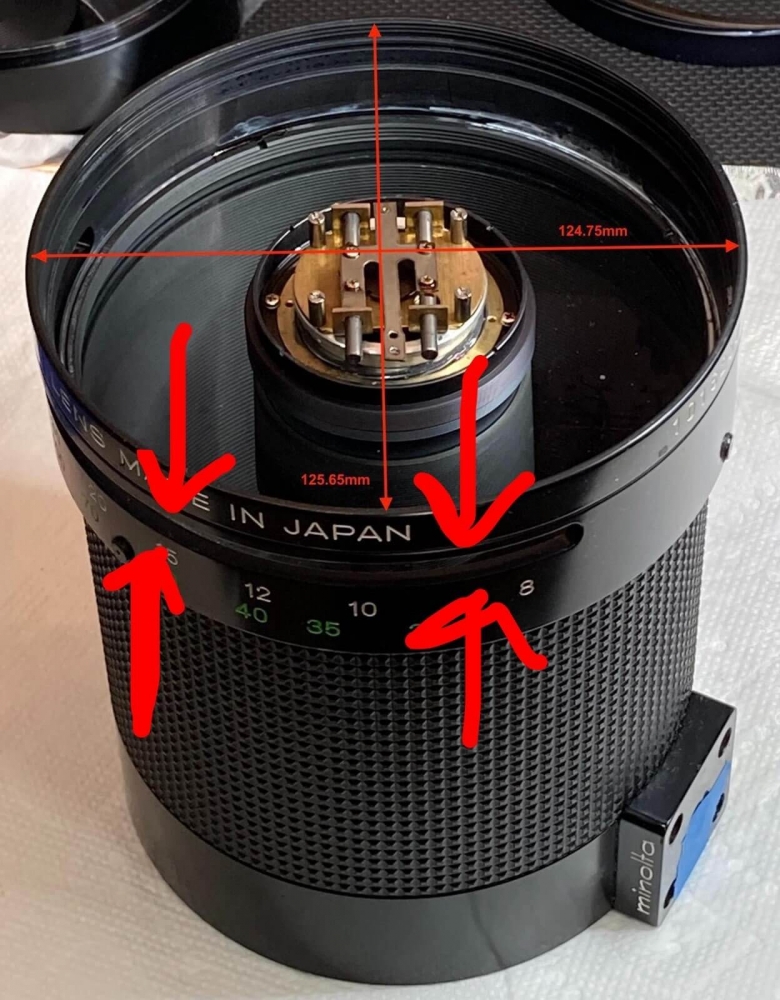
Rotating the lens to the right orientation made it obvious that the barrel was distorted. Someone had crushed the lens hard enough to make it oval and compress the weaker material forward of the focus slot, bending it towards the back of the lens. There was a sharp bend where I indicated with the arrow in the following photo.
#6
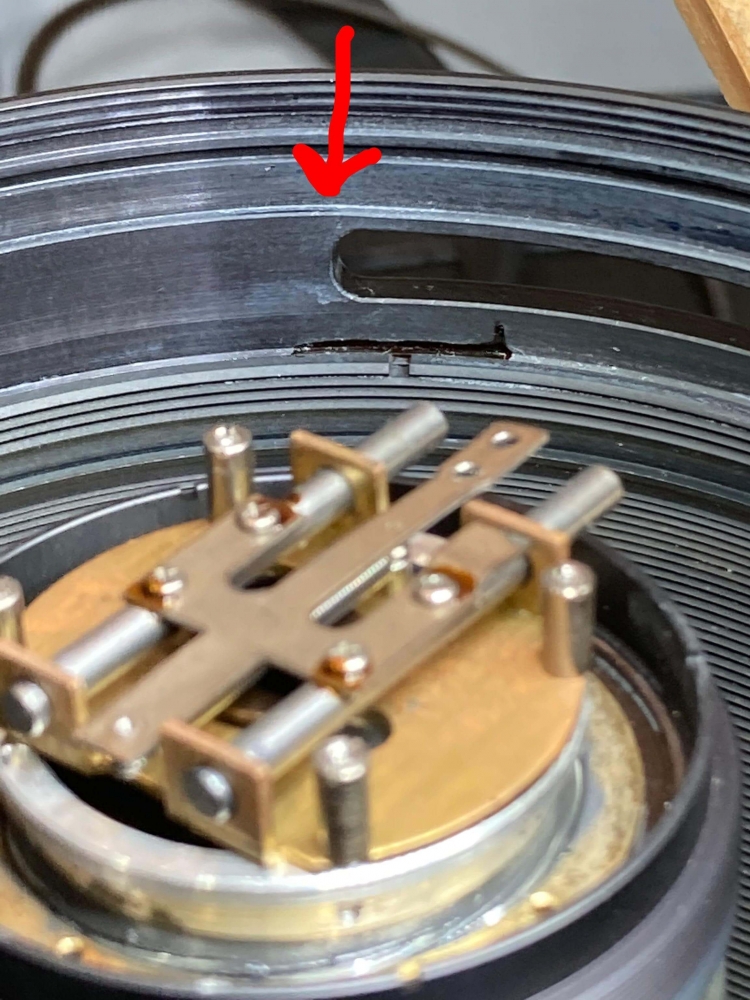
If you've handled one of these lenses you will appreciate how much force must have been required to bend it this much.
This explained all the problems I'd seen: stiff focus, focus skirt rocking back and forth on a high spot, stuck hood. At this point I realized the seller had definitely known the focus was frozen; it wasn't a matter of something drying out in storage and getting stiffer since the last time they'd taken a look. This lens's focus has been stuck ever since someone dropped it, and the seller couldn't have been unaware of it. Oh well, sometimes sellers are dishonest, that's life.
I thought about it for a while and decided to very gently and evenly pry the focus slot open again, using two wedge-shaped wooden carpentry shims and a clamp to drive them together against each other. After securing the lens and all the tools in a stable position, I did that, measuring and eyeballing my progress, and removing and measuring how much springback there was a couple of times. It worked quite well, and the lens barrel returned to nearly its normal shape. The pre-existing damage had caused a couple of sharp bends, which I am not equipped to remove (nor do I think that's likely to be possible), but those are minimized now, to the point that reassembly was easy without using force. And because I was careful and protected all surfaces before working, I didn't damage anything further.
I found that after reassembling, the focus action was quite nice, although there was still one spot where the resistance increased a bit. However, when I screwed the hood on again, it served to bring the barrel even more back into roundness, and the focus action became easy and even. I suspect that the lens had less focus resistance from the factory than it does now, but it's not a problem at all now in any case.
Unfortunately the lens isn't very sharp, even when tripod-mounted. Specular highlights have star shapes instead of being bright dots. I don't know if this is a matter of alignment or due to the chipped mirror. It strikes me as extremely unlikely that the chips could cause such a problem, because frankly they're so small. Here's an example, a tight crop (handheld). Note the gleam in the buzzard's eye.
#7
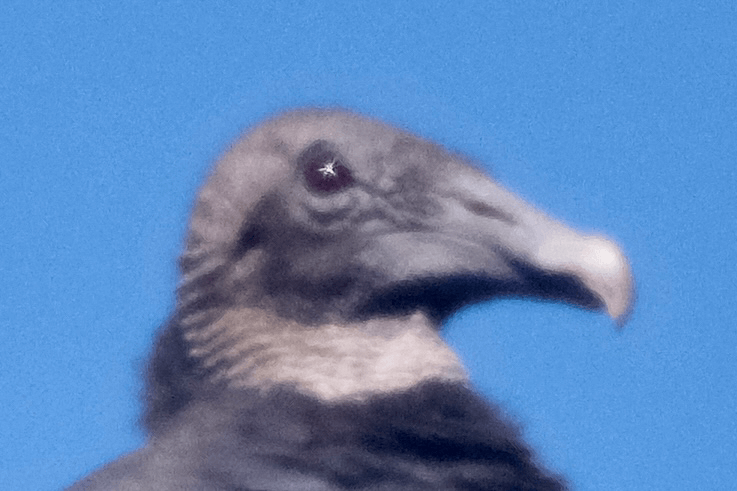
I am not sure if there's anything I can do to improve this, but I'm open to suggestions. In any case this lens was a lot of fun to diagnose and very satisfying to repair to the extent that I could. A well-kept copy of it would be a treat, if somewhat impractical (read: a fun challenge) to use! |
|
| Back to top |
|
 |
kiddo

Joined: 29 Jun 2018
Posts: 1120
|
 Posted: Fri Sep 24, 2021 9:12 pm Post subject: Posted: Fri Sep 24, 2021 9:12 pm Post subject: |
 |
|
kiddo wrote:
Thanks for your sharing . I've bought the 80cm version ,Wich might be pretty the same , and it camed in mich better shape I assume . The knob focus it's not 100% easy to use, even though it ain't stuck , it's only a bit unstable focusing on long distance . A very sturdy tripod still wouldn't be enough , a front ring holding the lens it would be nice. Optically speaking , your lens might need a collimator adjusting (at least is what some other fellow recommend it me a few weeks ago) . I haven't used the lens only once , after that I've noticed the rear filter wasn't totally clean , but here's an image I took just to try it
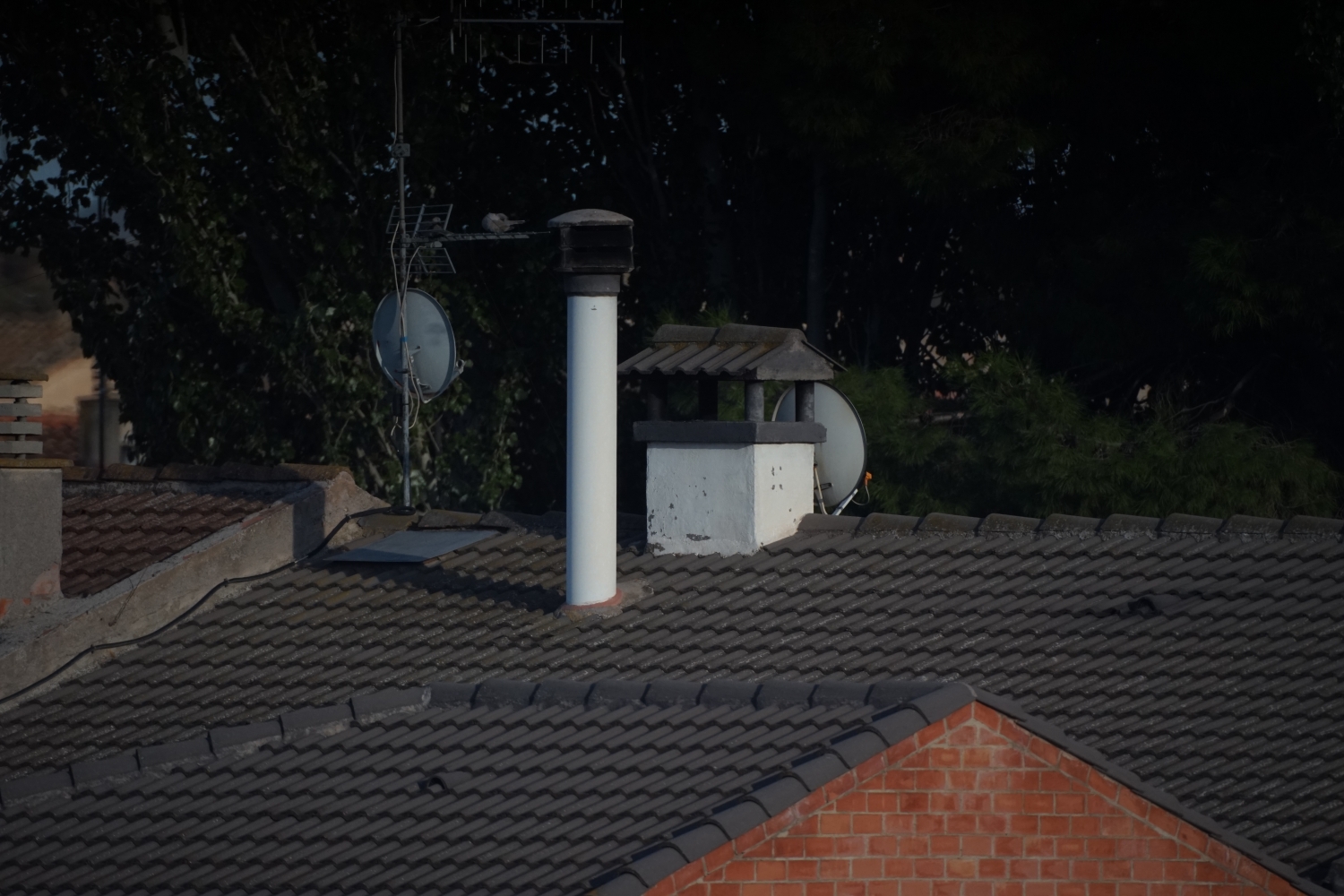 [/img] [/img] |
|
| Back to top |
|
 |
55


Joined: 13 May 2013
Posts: 708
Location: U.S.
Expire: 2022-06-15
|
 Posted: Sat Sep 25, 2021 4:36 am Post subject: Re: Minolta 800mm f8 Reflex Lens Posted: Sat Sep 25, 2021 4:36 am Post subject: Re: Minolta 800mm f8 Reflex Lens |
 |
|
55 wrote:
| xaprb wrote: |
. . .
In any case this lens was a lot of fun to diagnose and very satisfying to repair to the extent that I could. A well-kept copy of it would be a treat, if somewhat impractical (read: a fun challenge) to use! |

Wow, that was a lot of work! Thanks for sharing your saga with us.
It would be wonderful if you could get the optics fixed. |
|
| Back to top |
|
 |
stevemark

Joined: 29 Apr 2011
Posts: 3754
Location: Switzerland
|
 Posted: Sat Sep 25, 2021 7:26 pm Post subject: Posted: Sat Sep 25, 2021 7:26 pm Post subject: |
 |
|
stevemark wrote:
Very interesting indeed - thanks for sharing! It reminds me to get my Minolta 250mm and 500mm mirror lenses off the shelf and doing some "fun work" 
S
_________________
www.artaphot.ch |
|
| Back to top |
|
 |
kiddo

Joined: 29 Jun 2018
Posts: 1120
|
 Posted: Sun Sep 26, 2021 9:55 am Post subject: Posted: Sun Sep 26, 2021 9:55 am Post subject: |
 |
|
kiddo wrote:

A6000 extreme crop . Wonder what MD multiplier would be recommended to get closer ? |
|
| Back to top |
|
 |
xaprb

Joined: 28 Jan 2021
Posts: 168
|
 Posted: Mon Sep 27, 2021 11:08 am Post subject: Posted: Mon Sep 27, 2021 11:08 am Post subject: |
 |
|
xaprb wrote:
That is a very nice image. Perhaps the Vivitar 7-element Macro Focusing 2x teleconverter would be worth trying.
I have been thinking more about the bright rays of light coming from specular highlights in my copy of this lens. I assume that the same thing is happening to all light, not just bright spots, but I only see it clearly when there’s a bright sharp point that doesn’t render as a bright sharp point. I wonder if it IS in fact caused by the chips in the mirror scattering light, and if that is the case, whether it would be preferable to cover those chips with small black nonreflective dots. Can anyone who knows more about this advise me? Or is there another forum, like an astronomy forum, where people would know whether this hypothesis is valid? |
|
| Back to top |
|
 |
visualopsins


Joined: 05 Mar 2009
Posts: 10528
Location: California
Expire: 2025-04-11
|
 Posted: Mon Sep 27, 2021 11:19 am Post subject: Posted: Mon Sep 27, 2021 11:19 am Post subject: |
 |
|
visualopsins wrote:
| xaprb wrote: |
That is a very nice image. Perhaps the Vivitar 7-element Macro Focusing 2x teleconverter would be worth trying.
I have been thinking more about the bright rays of light coming from specular highlights in my copy of this lens. I assume that the same thing is happening to all light, not just bright spots, but I only see it clearly when there’s a bright sharp point that doesn’t render as a bright sharp point. I wonder if it IS in fact caused by the chips in the mirror scattering light, and if that is the case, whether it would be preferable to cover those chips with small black nonreflective dots. Can anyone who knows more about this advise me? Or is there another forum, like an astronomy forum, where people would know whether this hypothesis is valid? |
Have you checked collimation? 
_________________
☮☮☮☮☮☮☮☮☮☮☮☮☮☮☮☮☮☮☮☮☮☮☮☮☮☮☮☮☮☮☮☮ like attracts like! ☮☮☮☮☮☮☮☮☮☮☮☮☮☮☮☮☮☮☮☮☮☮☮☮☮☮☮☮☮☮☮☮
Cameras: Sony ILCE-7RM2, Spotmatics II, F, and ESII, Nikon P4
Lenses:
M42 Asahi Optical Co., Takumar 1:4 f=35mm, 1:2 f=58mm (Sonnar), 1:2.4 f=58mm (Heliar), 1:2.2 f=55mm (Gaussian), 1:2.8 f=105mm (Model I), 1:2.8/105 (Model II), 1:5.6/200, Tele-Takumar 1:5.6/200, 1:6.3/300, Macro-Takumar 1:4/50, Auto-Takumar 1:2.3 f=35, 1:1.8 f=55mm, 1:2.2 f=55mm, Super-TAKUMAR 1:3.5/28 (fat), 1:2/35 (Fat), 1:1.4/50 (8-element), Super-Multi-Coated Fisheye-TAKUMAR 1:4/17, Super-Multi-Coated TAKUMAR 1:4.5/20, 1:3.5/24, 1:3.5/28, 1:2/35, 1:3.5/35, 1:1.8/85, 1:1.9/85 1:2.8/105, 1:3.5/135, 1:2.5/135 (II), 1:4/150, 1:4/200, 1:4/300, 1:4.5/500, Super-Multi-Coated Macro-TAKUMAR 1:4/50, 1:4/100, Super-Multi-Coated Bellows-TAKUMAR 1:4/100, SMC TAKUMAR 1:1.4/50, 1:1.8/55
M42 Carl Zeiss Jena Flektogon 2.4/35
Contax Carl Zeiss Vario-Sonnar T* 28-70mm F3.5-4.5
Pentax K-mount SMC PENTAX ZOOM 1:3.5 35~105mm, SMC PENTAX ZOOM 1:4 45~125mm
Nikon Micro-NIKKOR-P-C Auto 1:3.5 f=55mm, NIKKOR-P Auto 105mm f/2.5 Pre-AI (Sonnar), Micro-NIKKOR 105mm 1:4 AI, NIKKOR AI-S 35-135mm f/3,5-4,5
Tamron SP 17mm f/3.5 (51B), Tamron SP 17mm f/3.5 (51BB), SP 500mm f/8 (55BB), SP 70-210mm f/3.5 (19AH)
Vivitar 100mm 1:2.8 MC 1:1 Macro Telephoto (Kiron)
|
|
| Back to top |
|
 |
xaprb

Joined: 28 Jan 2021
Posts: 168
|
 Posted: Mon Sep 27, 2021 11:25 am Post subject: Posted: Mon Sep 27, 2021 11:25 am Post subject: |
 |
|
xaprb wrote:
How can I do that? My impression is that you check collimation by taking a photo of a small bright light source… and if the chips in the mirror are causing rays of light to scatter about and turn such a light into a star shape, how would I know the difference between poor collimation and a chipped mirror? I have read a little about collimation but I feel like this lens might need more expertise than I possess to diagnose. That said, I did get some ball bearings and I will try it in my basement with an LED light, and see what happens! |
|
| Back to top |
|
 |
visualopsins


Joined: 05 Mar 2009
Posts: 10528
Location: California
Expire: 2025-04-11
|
 Posted: Mon Sep 27, 2021 3:23 pm Post subject: Posted: Mon Sep 27, 2021 3:23 pm Post subject: |
 |
|
visualopsins wrote:
Use a star or a flashlight with pinhole for point source. A circular mask the same diameter as lens front element with two 1" holes, one on each side of the center. Focus on the light source. See two points of light (needs collimation) or one? Then turn lens mask 90 degrees to check that angle. If instead of one or two points of light you see something like in bird's eye in photo above, then the problem is not collimation. If you see two "bird's eyes", then the lens also needs collimation.
_________________
☮☮☮☮☮☮☮☮☮☮☮☮☮☮☮☮☮☮☮☮☮☮☮☮☮☮☮☮☮☮☮☮ like attracts like! ☮☮☮☮☮☮☮☮☮☮☮☮☮☮☮☮☮☮☮☮☮☮☮☮☮☮☮☮☮☮☮☮
Cameras: Sony ILCE-7RM2, Spotmatics II, F, and ESII, Nikon P4
Lenses:
M42 Asahi Optical Co., Takumar 1:4 f=35mm, 1:2 f=58mm (Sonnar), 1:2.4 f=58mm (Heliar), 1:2.2 f=55mm (Gaussian), 1:2.8 f=105mm (Model I), 1:2.8/105 (Model II), 1:5.6/200, Tele-Takumar 1:5.6/200, 1:6.3/300, Macro-Takumar 1:4/50, Auto-Takumar 1:2.3 f=35, 1:1.8 f=55mm, 1:2.2 f=55mm, Super-TAKUMAR 1:3.5/28 (fat), 1:2/35 (Fat), 1:1.4/50 (8-element), Super-Multi-Coated Fisheye-TAKUMAR 1:4/17, Super-Multi-Coated TAKUMAR 1:4.5/20, 1:3.5/24, 1:3.5/28, 1:2/35, 1:3.5/35, 1:1.8/85, 1:1.9/85 1:2.8/105, 1:3.5/135, 1:2.5/135 (II), 1:4/150, 1:4/200, 1:4/300, 1:4.5/500, Super-Multi-Coated Macro-TAKUMAR 1:4/50, 1:4/100, Super-Multi-Coated Bellows-TAKUMAR 1:4/100, SMC TAKUMAR 1:1.4/50, 1:1.8/55
M42 Carl Zeiss Jena Flektogon 2.4/35
Contax Carl Zeiss Vario-Sonnar T* 28-70mm F3.5-4.5
Pentax K-mount SMC PENTAX ZOOM 1:3.5 35~105mm, SMC PENTAX ZOOM 1:4 45~125mm
Nikon Micro-NIKKOR-P-C Auto 1:3.5 f=55mm, NIKKOR-P Auto 105mm f/2.5 Pre-AI (Sonnar), Micro-NIKKOR 105mm 1:4 AI, NIKKOR AI-S 35-135mm f/3,5-4,5
Tamron SP 17mm f/3.5 (51B), Tamron SP 17mm f/3.5 (51BB), SP 500mm f/8 (55BB), SP 70-210mm f/3.5 (19AH)
Vivitar 100mm 1:2.8 MC 1:1 Macro Telephoto (Kiron)
|
|
| Back to top |
|
 |
woodrim


Joined: 14 Jan 2010
Posts: 4060
Location: Charleston
|
 Posted: Mon Sep 27, 2021 11:53 pm Post subject: Posted: Mon Sep 27, 2021 11:53 pm Post subject: |
 |
|
woodrim wrote:
I wouldn't expect the chips to be the major source of the problem. Are the chipped areas reflective? If so, maybe it would be a good idea to carefully apply dull black paint just in the chipped spots. The softness of the lens indicates a calibration issue, I'm pretty sure. Either main mirror or secondary could be off a tad. I see that the focusing bar is up against the wall where it comes through; could that be creating tension on the center portion? Is the center, secondary mirror insulated from the work you did when returning round to the cylinder?
_________________
Regards,
Woodrim |
|
| Back to top |
|
 |
xaprb

Joined: 28 Jan 2021
Posts: 168
|
 Posted: Sat Oct 02, 2021 10:33 am Post subject: Posted: Sat Oct 02, 2021 10:33 am Post subject: |
 |
|
xaprb wrote:
| visualopsins wrote: |
| Use a star or a flashlight with pinhole for point source. A circular mask the same diameter as lens front element with two 1" holes, one on each side of the center. Focus on the light source. See two points of light (needs collimation) or one? Then turn lens mask 90 degrees to check that angle. If instead of one or two points of light you see something like in bird's eye in photo above, then the problem is not collimation. If you see two "bird's eyes", then the lens also needs collimation. |
Super helpful, thank you. I will be trying this as soon as I get a chance. |
|
| Back to top |
|
 |
xaprb

Joined: 28 Jan 2021
Posts: 168
|
 Posted: Sat Oct 02, 2021 10:43 am Post subject: Posted: Sat Oct 02, 2021 10:43 am Post subject: |
 |
|
xaprb wrote:
| woodrim wrote: |
| I wouldn't expect the chips to be the major source of the problem. Are the chipped areas reflective? If so, maybe it would be a good idea to carefully apply dull black paint just in the chipped spots. The softness of the lens indicates a calibration issue, I'm pretty sure. Either main mirror or secondary could be off a tad. I see that the focusing bar is up against the wall where it comes through; could that be creating tension on the center portion? Is the center, secondary mirror insulated from the work you did when returning round to the cylinder? |
I think the center focusing mirror is pretty well protected from the work I did, and that assembly is decoupled in general from any forces on the focus lever except for rotational position. However, it’s hard to guess what might have happened to the lens and how it affected it.
The rear/primary mirror is not adjustable as far as I can tell, and as long as that rear section of the lens barrel (the rear cover) isn’t bent, I suspect that isn’t misaligned. It’s all too solid and precise, I think. I think it’s designed for the primary mirror to be set in place and automatically be perfectly aligned. Likewise with the first glass corrector element at the front of the lens. I didn’t see any shims or cams on that to adjust centering or tilt, although there could be; I could look more closely.
If there’s a way to make adjustments, I suspect it might be something between the secondary mirror and the focusing helicoid; perhaps there’s a suspension mechanism with screws to adjust tilt on two axes or something.
The other possibility I can think of is the final set of corrector elements inside the “tower” protruding from the primary mirror. Something in there could be knocked off alignment. But I doubt there’s any way to adjust that, too.
I’ll try to check collimation as suggested a couple of replies back, and go from there.
Of related interest, I happened to use my Canon nFD 500mm f8 mirror lens recently, and took some photos of “point light sources at infinity”, i.e. reflections off the engines and tail of an airplane a few miles up. They, too, had star-shaped aberrations. I’ll be interested to see if I can reproduce this more easily in my basement in a controlled environment. I might actually get less erratic at assessing sharpness and alignment of these lenses, who knows! |
|
| Back to top |
|
 |
woodrim


Joined: 14 Jan 2010
Posts: 4060
Location: Charleston
|
 Posted: Sat Oct 02, 2021 1:23 pm Post subject: Posted: Sat Oct 02, 2021 1:23 pm Post subject: |
 |
|
woodrim wrote:
I am not familiar with the Minolta 800, so this may or may not apply. My big Rubinar 5.6/500 had bad astigmatism when I first got it. I had been looking forward to the lens and was very disappointed when I had trouble focusing and the results were not sharp. On a hunch from something I had read, I loosened the tripod collar, the lens shade, and the screw-on adapter. Everything came into perfect focus. I never tried to figure out which one made the difference if not all three. I suspect it was the rear where the adapter was screwed tight; now I keep it very loose - just barely snug. Any difference to the shape of the lens barrel, lens front, or rear was imperceptible. I wonder if the out-of-round of the front of yours, either before or after you made the correction, might be the problem.
_________________
Regards,
Woodrim |
|
| Back to top |
|
 |
xaprb

Joined: 28 Jan 2021
Posts: 168
|
 Posted: Sat Oct 02, 2021 2:23 pm Post subject: Posted: Sat Oct 02, 2021 2:23 pm Post subject: |
 |
|
xaprb wrote:
On second thought, based on what you wrote, I would not be surprised if you’re right. If the front of the barrel is compressing the front element… it may only be a tiny amount, but glass is no more rigid and inflexible than other materials. It’s bound to be warped if it’s under a lot of stress. And even a tiny amount could be enough. |
|
| Back to top |
|
 |
woodrim


Joined: 14 Jan 2010
Posts: 4060
Location: Charleston
|
 Posted: Sat Oct 02, 2021 6:11 pm Post subject: Posted: Sat Oct 02, 2021 6:11 pm Post subject: |
 |
|
woodrim wrote:
| xaprb wrote: |
| On second thought, based on what you wrote, I would not be surprised if you’re right. If the front of the barrel is compressing the front element… it may only be a tiny amount, but glass is no more rigid and inflexible than other materials. It’s bound to be warped if it’s under a lot of stress. And even a tiny amount could be enough. |
Yes, a very tiny amount.
_________________
Regards,
Woodrim |
|
| Back to top |
|
 |
|
|
